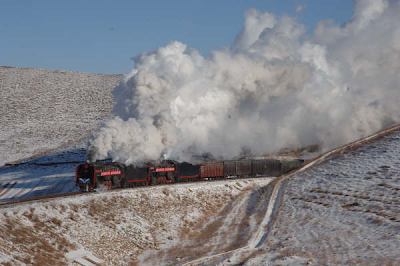Wednesday, April 18, 2007

Recommended :
 IAPWS is an international non-profit association of national organizations concerned with the properties of water and steam, particularly thermophysical properties and other aspects of high-temperature steam, water and aqueous mixtures that are relevant to thermal power cycles and other industrial applications.
IAPWS is an international non-profit association of national organizations concerned with the properties of water and steam, particularly thermophysical properties and other aspects of high-temperature steam, water and aqueous mixtures that are relevant to thermal power cycles and other industrial applications.Following tabulate listing of useful documents and links for STEAM & WATER engineering... if some of you have better site, please drop me a comments...
Steam Conservation Guidelines Handbook (Source : Armstrong)
Armstrong has been sharing know-how since they invented the energy-efficient inverted bucket steam trap in 1911. In the years since, customers’ savings have proven again and again that knowledge not shared is energy wasted. Armstrong’s developments and improvements in steam trap design and function have led to countless savings in energy, time and money. This section has grown out of our decades of sharing and expanding what we’ve learned.It deals with the operating principles of steam traps and outlines their specific applications to a wide variety of products and industries. This section also includes Recommendation Charts that summarize our findings on which type of trap will give optimum performance in a given situation and why.
Armstrong has been sharing know-how since they invented the energy-efficient inverted bucket steam trap in 1911. In the years since, customers’ savings have proven again and again that knowledge not shared is energy wasted. Armstrong’s developments and improvements in steam trap design and function have led to countless savings in energy, time and money. This section has grown out of our decades of sharing and expanding what we’ve learned.It deals with the operating principles of steam traps and outlines their specific applications to a wide variety of products and industries. This section also includes Recommendation Charts that summarize our findings on which type of trap will give optimum performance in a given situation and why.
 Condensate Recovery Handbook (Source : Armstrong)
Condensate Recovery Handbook (Source : Armstrong)The most basic part of energy management is utilizing all valuable Btu within the steam system. Depending on the pressure, condensate exiting a trap contains approximately 20% of the heat energy transferred at the boiler in the form of sensible heat. Effective recovery of condensate reduces three tangible costs of producing steam :
- Fuel/energy costs associated with producing steam
- Boiler water make-up and sewage treatment
- Boiler water chemical treatment
Steam Engineering Tutorial...
A comprehensive information and knowledge on Steam Engineering and Heat Transfer site (Source : Spirax Sarco)
 Water97_v13.xla (Alternative1,Alternative2)
Water97_v13.xla (Alternative1,Alternative2)A very useful MS EXCEL Add-In for calculating thermodynamic and transport properties of water and steam using the industrial standard IAPWS-IF97. (source : Cheresources)
Steam67.zip contains compiled dll version of the 1967 ASME Steam Tables and an Excel 97 example of using it. (source : KORF)
A web-base steam table generation for different Steam-Water regions :
- Sub Saturated Water Region
- Saturated Water Line
- Wet Steam Region
- Dry Saturated Steam Line
- Superheated Steam Region
Thermo Utilities v3.0(1.75 Mb) offers a large number of functions for calculating the properties of water, steam, air, flue gases and other fluids. The functions used for steam and water properties are based on a set of equations accepted by the members of the Sixth International Conference on the Properties of Steam. The sets of equations are also known as "IFC Formulation for Industrial Use". Thermo Utilities calculates the properties of dry air, moist air, exhaust and flue gases by using equations accepted by ASHRAE and CIBSE (Chartered Institute of Building Services Engineers). Lee-Kesler method used in this package can be applied to a large number of chemicals for estimating thermodynamic properties. The database accompanied with this package for use with Lee-Kesler method supports more than 450 chemicals. The package also offers a large number of inverse functions which are useful for applied thermodynamics calculations. (source : Taftan Data)
SteamTab™ (demo) add-in software, new water and steam properties formulation approved by the International Association for the Properties of Water and Steam (IAPWS)
(source : Chemicalogic)
Related Topic
Related Topic
- Management of Steam Asset
- Problems and Measures for Condensate Recycle Control Valve
- Understand Boiler Efficiency
- Simple Formula To Estimate Water Viscosity
- Square-root-Square-root Formula Ease Saturated Steam-Codensate Temperature Prediction
- SteamTab - A simple Executable file for Steam - Water Properties...
- Conduct Steam-Water Balance MANUALLY using Water97_v13
- Useful Steam - Condensate Calculator
- Condensate Pump Recirculation Valve Selection
- Steam in FIRE...
- "Fire from Ice"...
Labels: Condensate, Steam
2 Comments:
There are a lot of emerging technologies associated with the creation of the steam engine. I really like the links to various informative sites that you mentioned above. They provide the latest information about steam and its properties.
Barnes and Jones steam traps are also interesting brands of thermostatic steam traps. Barnes and Jones traps are very innovative because they introduces the use of 'cage units' which are convenient repair kits for most steam engines.
Looking forward to more information from your blog. Thanks!
Indeed, there are many varieties of steam traps today, it is important to choose right materials though. Steam trap is very vital for steam engine. It is use to discharge condensate and non condensable gases. Every trap has different use. If you get confuse on choosing the right trap, it's better to ask an expert for further information.
Post a Comment
Let us know your opinion !!! You can use some HTML tags, such as <b>, <i>, <a>
Subscribe to Post Comments [Atom]
Home:
<< Home